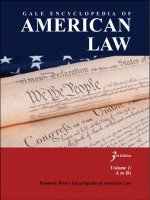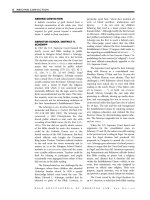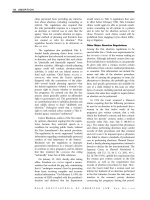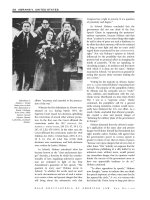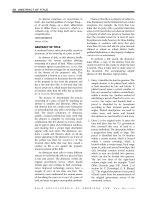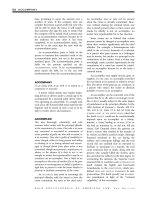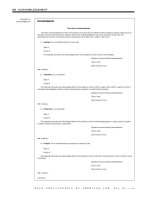Gale Encyclopedia Of American Law 3Rd Edition Volume 1 P18 pot
Bạn đang xem bản rút gọn của tài liệu. Xem và tải ngay bản đầy đủ của tài liệu tại đây (256.71 KB, 10 trang )
husband and his wife’s relations by blood, or
between the wife and the husband’s relations
by blood. Secondary affinity is between a spouse
and the other spouse’s relatives by marriage.
Collateral affinity exists between a spouse and the
relatives of the other spouse’s relatives. The
determination of affinity is important in various
legal matters, such as deciding whether to
PROSECUTE a person fo r INCEST or whether to
disqualify a juror for bias.
AFFIRM
To ratify, establish, or reassert. To make a solemn
and formal declaration, as a substitute for an oath,
that the statements contained in an affidavit are true
or that a witness will tell the truth. In the practice of
appellate courts, to declare a judgment, decree, or
order valid and to concur in its correctness so that it
must stand as rendered in the lower court. As a
matter of pleading, to allege or aver a matter of fact.
A judgment, decree, or order that is not
affirmed is either remanded (sent back to the
lower court with instructions to correct the
irregularities noted in the appellate opinion) or
reversed (changed by the appellate court so that
the decision of the lower court is overturned).
AFFIRMANCE
A declaration by an appellate court that a
judgment, order, or decree of a lower court that
has been brought before it for review is valid and will
be upheld.
AFFIRMATION
A solemn and formal declaration of the truth of a
statement, such as an affidavit or the actual or
prospective testimony of a witness or a party that
takes the place of an oath. An affirmation is also
used when a person cannot take an oath because
of religious convictions.
AFFIRMATIVE ACTION
Employment programs required by federal statutes
and regulations designed to remedy discriminatory
practices in hiring minority group members; i.e.,
positive steps designed to eliminate existing and
continuing discrimination, to remedy lingering
effects of past discrimination, and to create systems
and procedures to prevent future discrimination;
commonly based on population percentages of
minority groups in a particular area. Factors
considered are race, color, sex, creed, and age.
The idea of affirmative action was foresha-
dowed as early as the Reconstruction Era, which
followed the
U.S. CIVIL WAR. When that conflict
ended, the former slave population throughout
the South owned virtually nothing and had only a
limited set of skills with which they could make a
living. To help these newly emancipated citizens
sustain a minimal economic base, the victorious
ILLUSTRATION BY GGS
CREATIVE RESOURCES.
REPRODUCED BY
PERMISSION OF GALE,
APARTOFCENGAGE
LEARNING.
Percentage Distribution of Students Enrolled in Degree-Granting Institutions
a
, by Race/Ethnicity
Race/ethnicity
Percentage of total enrolled students
0
10
20
30
40
50
60
70
80
90
100
a
Accounts for both two- and four-year institutions.
SOURCE: U.S. Department of Education, National Center for Education Statistics, Digest of Education Statistics, 2007.
84.3
White
67.4
9.6
13.3
Black
3.6
Hispanic
11.4
1.8
Asian/Pacific
Islander
6.8
1.1
American
Indian/Alaska
Native
0.7
1976
2006
GALE ENCYCLOPEDIA OF AMERICAN LAW, 3RD E DITION
158 AFFIRM
General William T. Sherman proposed to divide
up the land and goods from the sizable planta-
tions of southeastern Georgia that were under his
command and grant to each fam ily of color
“40 acres and a mule.” The proposal ran into
powerful political opposition, however, and it
was never widely adopted.
Nearly a century later, this idea of assisting
whole classes of individuals to gain access to the
goods of U.S. life reemerged in U.S. law and
society through a series of court decisions and
political initiatives interpreting the
CIVIL RIGHTS
guarantees within the EQUAL PROTECTION Clause of
the FOURTEENTH AMENDMENT. These decisions and
initiatives came to be known as affirmative action.
The term itself refers to both mandatory and
voluntary programs intended to affirm the civil
rights of designated classes of individuals by
taking positive action to protect them from, in
the words of Justice William J. Brennan Jr., “the
lingering effects of pervasive discrimination”
(Local 28 of the Sheet Metal Workers’ International
Association v. EEOC, 478 U.S. 421, 106 S. Ct.
3019, 92 L. Ed. 2d 344 [1986]). A law school, for
example, might voluntarily take affirmative
action to find and admit qualified students of
color. An employer might recruit qualified
women where only men have worked before,
such as businesses that operate heavy equipment.
Affirmative action developed during the four
decades following the decision in Brown v. Board
of Education, 347 U.S. 483, 74 S. Ct. 686, 98 L.
Ed. 873 (1954). In Brown, the Supreme Court
held that public school
SEGREGATION of children
by race denied minority children equal educa-
tional opportunities, rejecting the doctrine of
“separate but equal” in the public education
context. During the 1960s and early 1970s, the
CIVIL RIGHTS MOVEMENT as well as the VIETNAM WAR
inspired members of minorities and women to
advocate collectively for increased equality and
opportunity within U.S. society. These groups
appealed for equal rights under the Fourteenth
Amendment, and they sought opportunity in the
public arenas of education and employment. In
many ways, they were successful. As affirmative
action grew, however, it drew increasing criti-
cism, often from men and whites, who opposed
what they viewed as “reverse discrimination.”
While the Brown decision declared segregat-
ed schools unlawful, it did not create affirmative
action to remedy discriminatory practices. A
decade after Brown, little had change d to
integrate the nation’s schools. The Court acted
ahead of business executives and legislatures
when it mandated, in Green v. County School
Board, 391 U.S. 430, 88 S. Ct. 1689, 20 L. Ed. 2d
716 (1968), that positive actions must be taken
to integrate schools. There followed the adop-
tion of an array of devices such as redistricting,
majority-to-minority transfers, school pairings,
magnet schools, busing, new construction, and
abandonment of all-black schools.
The first major legal setback for voluntary
affirmation action was the decision in Regents of
the University of California v. Bakke, 438 U.S. 265,
98 S. Ct. 2733, 57 L. Ed. 2d 750 (1978), in which
the Supreme Court struck down an admissions
plan at the University of California, Davis,
medical school. The plan, which had
SET ASIDE
16 places for minority applicants, was challenged
by white applicant Allan Bakke, who had been
refused admission even though he had higher
test scores than some of the minority applicants.
The Court held that by setting aside a specific
number, or quota, of places by race, the school
had violated Bakke’s civil rights. By denying the
“set-aside” practice of an affirmative action plan,
the decision seemed to threaten the principle
underlying affirmative action as well.
The following year, however, the Court
found in United Steelworkers v. Weber, 443 U.S.
193, 99 S. Ct. 2721, 61 L. Ed. 2d 480 (1979), that
the voluntary plan of Kaiser Aluminum Com-
pany to promote some of its black workers into
a special training program ahead of more senior
white workers did not violate the latter’scivil
rights when it did not involve quotas. The Court
also found in Local 28 of Sheet Metal Workers’
International Association v. EEOC, 478 U.S. 421,
106 S. Ct. 3019, 92 L. Ed. 2d 344 (1986), that
rights were not being violated by a court-
ordered me mbership goal of 29.23 percent
minorities. Writing for the
PLURALITY, Justice
Brennan said Title VII of the Civil Rights Act of
1964 does not prohibi t courts from ordering
“affirmative race-conscious relief as a remedy
for past discrimination” in appropriate circum-
stances. Such circumstances might include
“where an employer or
LABOR UNION has engaged
in persistent or egregious
DISCRIMINATION,or
where necessary to dissipate the lingering effect
of pervasive discrimination.”
The Court later found, in City of Richmond v.
J.A. Croson Co., 488 U.S. 469, 109 S. Ct. 706, 102
L. Ed. 2d 854 (1989), that the Minority Business
GALE ENCYCLOPEDIA OF AMERICAN LAW, 3RD E DITION
AFFIRMATIVE ACTION 159
Utilization Plan of Richmond, Virginia, violated
the rights of private contractors. The plan, which
required 30 percent of all subcontracts to be
awarded to minority-owned companies, was
struck down because this municipality had failed
to show compelling
STATE INTEREST for such a
measure. The Court applied the compelling
interest test after holding that race-based action
by state and local government was subject to
STRICT SCRUTINY. The Court extended this to the
federal government in Adarand Constructors, Inc. v.
Pena, 115 S. Ct. 2097, 132 L. Ed. 2d 158 (1995).
In Johnson v. Transportation Agency, 480 U.S.
616, 107 S. Ct. 1442, 94 L. Ed. 2d 615 (1987), the
Court ruled that a county agency had not violated
Title VII of the Civil Rights Act when, as part of
an affirmative action plan, it took a female
employee’s gender into account in promoting her
ahead of a male employee with a slightly higher
test score. The Court held that a “manifest
imbalance” existed in this workforce because of
an underrepresentation of women, and that the
employer had acted properly in using a “moder-
ate, flexible, case-by-case approach to effecting a
gradual improvement in the representation of
minorities and women.”
At issue in affirmative action cases is
whether the Equal Protection Clause of the
Fourteenth Amendment can be employed to
advance the welfare of one class of individuals
How Much Affirmative Action Is
Enough Affirmative Action?
I
n the combustive debate over affirma-
tive action, fairness is the hottest issue
of all. Most people agree that employers
should hire and promote people fairly.
Does affirmative action make this happen?
Americans disagree sharply: A July 1995
Associated Press poll found that
39 percent think it does, but 48 percent
said giving preference to women and
minorities produces even greater unfair-
ness. These numbers barely scratch the
surface of the antagonismsina debate now
more than 30 years old. Proponents argue
that the benefits of affirmative action
policies are
TANGIBLE, deserved, and neces-
sary. Opponents reply that these benefits
hide the real harm done by affirmative
action: rewarding the wrong people, deva-
luing the idea of merit, and punishing
white men. The two sides disagree on what
should be done, yet there is no shortage of
ideas. In the 1990s a flurry of arguments
came from politicians, academics,
CIVIL
RIGHTS
leaders, and reformers that are
aimed at preserving, modifying, or ending
affirmative action.
History has drastically rewritten the
terms of this debate. In the years of great
advances in federal civil rights, Presidents
JOHN F. KENNEDY and LYNDON B. JOHNSON
could easily frame the issue as a purely
moral one. Johnson put it this way in
1965:
Freedom is not enough You
do not take a man who for years
has been hobbled by chains,
liberate him, bring him to the
starting line of a race, saying, “you
are free to compete with all the
others,” and still justly believe
you have been completely fair.
Thus it is not enough to open the
gates of opportunity.
Thirty years later, Senate majority
leader Bob Dole (R-Kan.) made this
widely quoted attack: “The race-counting
game has gone too far.” Polls indicate
that both Johnson and Dole spoke for
a majority of citizens of their time.
Johnson captured the essence of a nation
willing to move beyond the legacy of
JIM
CROW LAWS
. Dole summoned the resent-
ment of white males who had seen the
affirmative action net expand to hold not
only minorities but also women and
immigrants. But white men are hardly
the only complainers: According to a
March 1995 Washington Post-ABC News
poll, 79 percent of middle-class white
women oppose preferences for women.
For affirmative action’s strongest
supporters, explaining the new harshness
in the policy’s politics is a matter of going
back to the beginning. They point out
that affirmative action was never sup-
posed to be painless. Making room for
groups that have historically suffered
DISCRIMINATION means that the very group
that did not suffer—white males—now
has to do so. This can be characterized as
the sins-of-the-fathers argument, illus-
trated in a 1995 briefing paper from the
AMERICAN CIVIL LIBERTIES UNION (AC LU):
“[W]hile it’struethatwhitemalesinany
given era may not all h ave been
responsible for excluding people of
color and women, all white males have
benefited unjustly from that historical
exclusion [thus enjoying] privileged
status and an unfair advantage.” This
position is supported by statistics: in
1995 white males held nearly 95 percent
of senior management positions in
major corporations, earned 25 to 45
percent mor e than women and minor i-
ties, and held well ove r 80 percent of the
seats in Congress. On the other hand,
from 197 3 to 1993, black pov erty
increased from 31.4 to 33.1 p erce nt.
Without doubt, discrimination con-
tinues; from the perspective of suppor-
ters of affirmative action, the sins of the
fathers are far from paid for.
GALE ENCYCLOPEDIA OF AMERICAN LAW, 3RD E DITION
160 AFFIRMATIVE ACTION
for compelling social reasons even when that
advancement may infringe in some way upon
the life or liberty of another. The continuing
existence of affirmative action laws and pro-
grams suggests that, so far, the Supreme Court’s
answer has been yes.
Affirmative action plans may be undertaken
voluntarily, as in the case of a private school’s
admissions goals; imposed by the courts to
protect civil rights; or required by law to qualify
for federal contracts. Plans required to qualify
for federal contracts are enforced by the Office
of Federal Contract Compliance Programs
(OFCCP), an agency of the U.S.
LABOR DEPART-
MENT
. The OFCCP defines its mission with its
critics in mind: “Affirmative action is not
preferential treatment. Nor does it mean that
unqualified persons should be hired or promot-
ed over other people. What affirmative action
does mean is that positive steps must be taken
to provide equal employment opportunity”
(EEOC, U.S. Labor Department, Pub.
No. 2850, Making EEO and Affirmative Action
Work 8 [1993]). One ranking OFCCP adminis-
trator defended the program even more sharply
by saying, “Affirmative action is not about goals
and has nothing to do with preferences. It is
about inclusion versus exclusion: people who
have been excluded from participation in the
process for years are now to be included.”
Because equality still eludes the
beneficiaries of affirmative action, sup-
porters dismiss attacks on the policies as
part of a backlash. Three decades of
advances for affirmative action’s bene-
ficiaries have meant diminished domi-
nance for white men, a group whose
income has been falling in real terms
since 1973. But, supporters say, the
reason white men earn less today than
their fathers did is not the fault of
affirmative action. They point to long-
term changes in the U.S. economy and
job market as the real explanations for
stagnating incomes, diminishing buying
power, and decreasing job security. Yet
affirmative action gets the blame. “We
are the ultimate scapegoat for whatever
goes wrong,” Mary Frances Berry, chair-
woman of the U.S.
COMMISSION ON CIVIL
RIGHTS
, told the Boston Globe in 1995.
Dwindling support from middle-class
white women also draws the ire of
affirmative action’s advocates. “In the
1970s and 80s, white women had no
problem hitching up to the affirmative
action banner of ‘women and min-
orities,’” journalist Derrick Z. Jackson
wrote. “If they now want to rip down the
banner, it will confirm the dirtiest little
secret of all about affirmative action”—
that white women supported it only to
the extent that it benefited themselves.
Dismissing these explanations as
excuses, critics of affirmative action de-
nounce it as “reverse discrimination.” They
either reject outright the idea that historical
wrongs can be redressed through contem-
porary means, or believe that the cost to
those who must pay for such redress is too
high. Conservative think tanks such as the
Institute for Justice and the
HERITAGE
FOUNDATION
regularly lead this prong of
the attack. Clint Bolick, the Institute for
Justice’s vice president, told Congressional
Quarterly, “If you add up the number of
people who have encountered reverse
discriminationin college admissions, scho-
larships, public school magnet programs,
government contracts and jobs in the
private and public sectors, you have a
pretty sizable population.” The charge
strikes the strongest advocates of affirma-
tive action as insupportable. According to
the research of law professor Alfred
Blumrosen, of Rutgers University, only a
few dozen such cases reached the federal
courts in the early 1990s, and in most, the
PLAINTIFF failed. Other advocates see the
reverse discrimination argument as sour
grapes; the ACLU goes so far as to call it a
smoke screen “for retention of white male
privilege.”
Critics frequently argue that affirma-
tive action does an injustice to the idea of
merit. Organizations representing police
officers and firefighters, such as the
national Fraternal Order of Police, com-
plain that qualifications and standards have
fallen to accommodate affirmative action
candidates. This criticism is popular not
only with whites, who have long claimed
that better qualified candidates lose out as a
result of affirmative action, but also with
two leading conservative African American
critics. “What we’ve had to do for 25 years
to pull off affirmative action,” the author
Shelby Steele said, “is demean the idea of
merit.” The economist Thomas Sowell
advances much the same argument in his
claim that the policy hurts African Amer-
icans. Like other conservatives, Sowell ties
the rise of affirmative action in the 1970s to
the development of the black economic
underclass. Steele and Sowell have argued
that affirmative action sets up its benefici-
aries for failure, corrupting the value of
achievement for blacks and reinforcing
racist stereotypes for whites. Viewing
affirmative action as antidemocratic, they
conclude that individual qualities alone
should determine who is hired or accepted
into an academic program.
Advocates are highly suspicious of
the merit argument. In the first place,
they deny that creating opportunities
ignores the value of personal merit.
Voluntary affirmative action merely gives
people who traditionally have been
excluded a leg up, they assert; and when
it is court ordered to redress a pattern of
workplace discrimination, the question
of merit misses the point. More crucially,
supporters think the merit line is super-
ficial. Political commentator Michael E.
Kinsley quipped that critics “seem to
imagine that everyone in America can be
ranked with scientific precision, from
No. 1 to No. 260,000,000, in terms of his
or her qualification for any desirable
career opportunity.” He and other
GALE ENCYCLOPEDIA OF AMERICAN LAW, 3RD E DITION
AFFIRMATIVE ACTION 161
Affirmation action plans are subject to
mandatory compliance procedures, which may
include monitoring by review, conciliation of
disputes, exclusion from federal contract work,
or even suit by the
DEPARTMENT OF JUSTICE.
Criticism of affirmative action has been
constant since the Supreme Court first articu-
lated its views. By the 1990s, opponents began
to press the Court to reverse its precedents both
in employment and in higher education admis-
sion policies. Supp orters of affirmati ve action
openly worried that the Court would severely
restrict affirmative action. For example, in 1997,
the Court was scheduled to hear an appeal
involving a New Jersey schoolteacher who
claimed she had suffered discrimination because
of an improper affirmative action plan (Taxman
v. Piscataway Township Board of Education,91
F.3d 1547 [3d. Cir. 1996]). Weeks before oral
argument, supporters of affirmative action
made the schoolteacher a financial
SETTLEMENT
in return for her dismissing the case. They
admitted that this was hardly a victory, but
supporters pointed to troubling developments.
One of these de velopments was the Supreme
Court’s refusal to review a decision that struck
supporters consider the argument spe-
cious in a society in which merit is often
the last reason for success and other
variables that give advantages to certain
groups are deemed perfectly natural—the
children of the rich attend the best schools
regardless of their abilities, for example,
and military veterans receive preferences
whether or not they have personally
sacrificed anything for the nation. The
United States was never a meritocracy,
asserts Laura Murphy Lee, director of the
ACLU’s national legislative office: “Affir-
mative action didn’t come along to taint a
process that never existed.”
Proposals for reforming affirmative
action became increasingly popular in the
mid-1990s. At one extreme, politicians
have called for dumping it altogether. This
idea has been urged in Congress chiefly by
ultraconservative Republicans such as
Senators Phil Gramm (R-Tex.) and
JESSE
HELMS
(R-N.C.). Although no action
has been taken on the congressional
level, similar proposals in the states of
California and Florida have gained
ground. California reformers scored two
victories in the mid-1990’s: First, in 1995,
regents of the University of California,
Regents of Univ. of Cal. v. Bakke, 438 U.S.
265, 98 S. Ct. 2733, 57 L. Ed. 2d 750
(1980) dropped gender- and race-based
admissions, hiring, and contracting.
Then, reformers succeeded in passing an
anti-affirmative action referendum—the
California Civil Rights Initiative, a mea-
sure that would outlaw gender- and
race-based preferences in government
programs—in 1996. A similar
REFERENDUM
passed in Washington State in 1998.
Less radical and perhaps more polit-
ically feasible, another proposal calls for
preserving affirmative action while shift-
ing its emphasis. The idea would aban-
don race and gender as yardsticks and
match preferences solely with economic
need. Conservatives again lead this
campaign, but it draws some support
even from moderates: President
BILL
CLINTON
, declaring that his administration
was against quotas and guaranteed
results, ordered a review of federal
employment policies in 1995 to ensure
that they were being applied fairly.
Critics of affirmative action believe that
this kind of reform would ensure oppor-
tunity for disadvantaged people while
ending what they see as egregious abuses,
such as the awarding of contracts to rich
minority-owned businesses. Traditional
supporters agree that affirmative action
benefits do not always help the people who
most need them. But they believe that
substantial gains should not be reversed,
and that any need-based measurement
should only augment—not replace—
existing policies.
The journey of affirmative action
from its heyday to the present reflects
great changes in the United States.
Between the administration of President
Johnson and the Republican-controlled
Congress elected in 1994 lies a thirty-year
experience with
GREAT SOCIETY initiatives
that has left many citizens soured on the
idea of government assistance. Radical
changes in the nation’s economy and
workforce have surely not made the
journey any easier. Bridging this gap
seems unlikely, given the vastly different
history of white males on the one hand,
and women and people of color on the
other. From these two poles of experi-
ence, two opposing ideas of necessity
emerge. Critics say the time is ripe to
overhaul affirmative action, a well-inten-
tioned policy gone bad. Supporters,
perceiving a playing field that is still far
from level, maintain that the real work of
affirmative action has scarcely begun.
In the early 2000s, the battlefield
for a ffir mative action has s hifted from
How Much Affirmative Action Is Enough
Affirmative Action?
(Continued)
GALE ENCYCLOPEDIA OF AMERICAN LAW, 3RD E DITION
162 AFFIRMATIVE ACTION
down a university admission plan that used race
as one factor for acceptance. In Hopwood v.
Texas, 78 F. 3d. 932 (5th Cir. 1996), the U.S.
Court of Appeals for the Fifth Circuit ruled that
the practice of providing preferential treatment
to minorities in a public university’s admissions
policy was repugnant to the Constitution.
The University of Texas Law School imple-
mented an admissions policy in which the
standards for admission were lowered for minori-
ties. The school employed an index (called the
Texas Index, or TI) that combined standardized
test scores with grade-point averages. A minimum
score for acceptance was ten points higher for
whites than for non-whites. The appeals court
found problems with the structure of the TI.
While minorities, specifically African Americans
and Mexican Americans, earned scores sufficient
to be categorized as “presumptive admits” (i.e.,-
certain to be accepted), whites who received the
same scores were categorized as “presumptive
denials” (i.e., certain to be rejected). The court
invalidated the admissions policy, concluding that
using race as a criteria foradmissions isas arbitrary
as using one’s blood type.
In Grutter v. Bollinger, 539 U.S. 306, 123
S. Ct. 2325, 156 L.Ed.2d 304, the U.S. Supreme
Court narrowly endorsed the use of race in
choosing students for America’s top universities
and the concept of racial diversity as a
the workplace to education. Higher
education—the arena that gave birth to
Bakke, the first significant Supreme Court
decision endorsing affirmative action—has
more recently produced a mishmash of
court decisions a nd l aws t hat have called
into question the f uture of a ffirmative
action. There were arguments not just how
Bakke should be a pplied, but whether it
should be applied at all.
Higher education has been a partic-
ularly contentious area on affirmative
action for many reasons. Because many
higher education institutions are public,
there is an issue of whether taxpayer
money should be going to institutions
supporting affirmative action. The public
status of colleges and universities also
ensures that affirmative action debates
will be conducted out in the open. Also,
the quality and prestige of a college or
university is often seen as determining
where someone will end up on the
socioeconomic scale after graduation,
making the affirmative action stakes at
such institutions high.
In a reversal of the way they tolerated
discrimination through most of the twen-
tieth century, many colleges and universi-
ties now seem anxious to employ affirma-
tive action to increase the diversity of their
campuses. Court cases litigating affirma-
tive action in higher education are
brought by disgruntled white students
and parents claiming “reverse discrimina-
tion” It has been the courts and the
legislatures, not the colleges and the
universities, that have shown willingness
to put the brakes on affirmative action.
The battle over Bakke and its effects
on higher education swung into focus in
1996, when the 5th
CIRCUIT COURT of
Appeals struck down affirmative action
in college admissions in their decision
Hopwood v. Texas, 78 F.3d 932, 5th Cir.
(Tex. 1996). The decision covered insti-
tutions in the states of Texas, Louisiana,
and Mississippi. Within a year o f that
ruling, enrollments by minorities in higher
education institutions dropped in all three
states.
In response, the state of Texas
guaranteed a place in a state university
or college to anyone who had graduated
in the top 10 percent of their class. This
gave more minorities a chance, and as a
result minority enrollment at higher
education institutions in the state was
higher in 2001 than it was in the year
before Hopwood . Several other states,
including California and Florida, have
adopted versions of Texas’“10 percent”
solution. Critics have charged that these
programs are inadequate, failing to
ensure that minorities are represented
at the most prestigious institutions even
when they do boost enrollment in state
university systems overall.
The affirmative action focus in
higher education has shifted over to the
University of Michigan. White applicants
to both the undergraduate school and the
law school at the University of Michigan
sued on reverse discrimination grounds.
One U.S. district judge in Michigan
upheld the undergraduate program, and
another struck down the law school
program. A divided Sixth Circuit Court
of Appeals ruled in favor of the program
in Grutter v. Bollinger, 288 F.3d 732, 6th
Cir. (Mich. 2002) and the U.S Supreme
Court agreed to hear the appeal of that
decision. The Court upheld its decision
in 2003.
The administration of
GEORGE W. BUSH
filed a brief opposing Michigan’s affir-
mative action program. “The method
used by the University of Michigan to
achieve this important goal is fundamen-
tally flawed,” said President Bush in
statement. Defending the policy, Michigan
President Mary Sue Coleman said the
President “misunderstands how our ad-
mission process works” and denied it was
unconstitutional. Who the Supreme Court
decides is r ight may decide the future of
affirmative action in America.
FURTHER READINGS
Buchanan, Sidney. 2002. “Affirmative Action:
The Many Shades of Justice.” Houston
Law Review 39 (summer).
“Coloring the Campus.” 2001. Time Magazine
(September 17).
Goldstein, Amy, and Dana Milbank. 2003.
“Bush Joins Admissions Case Fight; U-
Mich. Use of Race Is Called ‘Divisive’.”
Washington Post (January 16).
GALE ENCYCLOPEDIA OF AMERICAN LAW, 3RD E DITION
AFFIRMATIVE ACTION 163
compelling governmental interest. In a LANDMARK
decision with wide-ranging implications for
affirmative action programs across the United
States, the Court ruled that it does not violate the
Equal Protection Clause to give some preferential
treatment to disadvantaged minorities, calling
the diversity that minorities bring to education,
business, and the military necessary for the
cultivation of “a set of leaders with legitimacy in
the eyes of the citizenry.” In that case, the Court
held that promoting racial diversity on campuses
not only serves a compelling government inter-
est,butalsothatthelawschool’s admissions
program was narrowly tailored and focused on
each applicant as an individual as opposed to
being a member of a particular racial group.
However, the victory for affirmative action was
conditional, as the Court emphasized that racial
preferences should be a temporary, rather than
permanent, fixture in American society, and
called for “periodic reviews” and “sunset provi-
sions” for race-conscious admissions.
In the 5–4 decision, written by Justice
Sandra Day O’Connor and joined by joined by
Justices
JOHN PAUL STEVENS, DAVID SOUTER , RUTH
BADER GINSBURG
, and STEPHEN BREYER, the Court
ruled that attaining a diverse student body is at
the heart of a law school’s proper institutional
mission, and that
GOOD FAITH on the part of a
university in pursuing diversity should be
presumed absent a showing to the contrary.
The Supreme Court emphasized that the law
school sought to enroll a “critical mass” of
minority students, not simply to ensure that its
student body had some specified percentage of a
particular group. In concluding that the law
school’s admissions policy was narrowly tailored,
the Supreme Court stated that the policy did not
operate as a quota, but used race as a “plus” factor,
such that the policy was flexible enough to ensure
that each applicant was evaluated as an individual.
The
PLAINTIFF was a white Michigan resident
whose application was rejected by the law
school. She alleged that her application was
denied because the law school use d race as a
“predominant factor. ” A district court agreed
with the plaintiff, but the U.S. Court of Appeals
for the Sixth Circuit reversed.
In Gratz v. Bollinger, a separate 6–3 decision
handed down the same day as Grutter v. Bollinger,
the Court struck down a separate University of
Michigan undergraduate-ad missions process
based on a point system that rated students and
awarded additional points to minorities. Because
the admissions process made race a “decisive”
factor, rather than just one of many in determin-
ing who was admitted, the Court ruled that the
formulaic approach was unconstitutional. Gratz
v. Bollinger, 539 U.S. 244, 123 S. Ct. 2411, 156 L.
Ed.2d 257. The opinion was delivered by Chief
Justice
WILLIAM REHNQUIST, who was joined by
Justices O’Connor,
ANTONIN SCALIA, ANTHONY
KENNEDY
, and CLARENCE THOMAS.
This point-system ruling is expected to force
state schools that use similar numerical meth-
ods to revise them, and it could cause compa-
nies to rethink their reliance on quantitative
evaluations of job applicants and employees.
Although Michigan is a public university, the
decision is considered likely to apply to selective
private universities as well, becaus e they receive
government funding. It also will affect admis-
sions practices at selective public high schools
where affirmative action has also been eliminat-
ed or curtailed.
Distaste for affirmative action also led
opponents to attack the policy at the state level
through ballot initiatives and referendums. In
November 1998 the California electorate passed
Proposition 209 (54 to 46 percent), which
banned many of the affirmative action programs
in California. The
REFERENDUM was promoted by
the nonprofit Center for Individual Rights, which
was also instrumental in building opposition to
the University of Texas admissions policy that
was struck down in Hopwood. The proposition
has remained a controversial topic, with supp or-
ters arguing that state and local officials have
avoided dismantling affirmative action. These
same supporters continue to call on state officials
to enforce the law. Officials, however, have
pointed out that under the proposition, when
federal laws mandate affirmative action to qualify
for federal monies, the state law must give way.
In 1998 Washington State passed Initiative
200 and became the second state to abolish state
affirmative action measures. The initiative is
similar to that of California’s Proposition 209.
In 2000 Florida became the first state to
voluntarily end affirmative action in higher
education and state contracts. Public universi-
ties put into place new college admissions
policies that prohibit affirmative action. One
new component was the Talented 20 Plan,
which mandates that students who graduate in
the top 20 percent of their class and who
GALE ENCYCLOPEDIA OF AMERICAN LAW, 3RD E DITION
164 AFFIRMATIVE ACTION
complete a college preparatory curriculum must
be admitted into one of the ten state universi-
ties. These changes were designed to increase
opportunity and diversity while endin g racial
preferences and set-a sides.
On June 28, 2007, the Supreme Court issued
a landmark decision in two joined cases
involving race and public school systems. In
Meredith v. Jefferson County Board of Education,
and Parents Involved in Community Schools v.
Seattle School District No. 1, the Court ruled that
race cannot be a factor in assigning children to a
particular public school. In both cases, the
school districts used race as the primary factor
in determining which school the students would
attend in order to maintain some level of racial
integration in the school districts. Chief Justice
JOHN ROBERTS, writing for the majority, argued
that racial integration does not justify assigning
students to a school based on the racial category
under which they fall. He further stated that “the
way to stop discrimination on the basis of race is
to stop discriminating on the basis of race.”
The fate of affirmative action in this country
is unclear. In November 2008 two states,
Nebraska and Colorado, had ballot measures
proposing to ban affirmative action preferences
by public entities. The ban passed in Nebraska
with more than 50 percent of the vote, whereas
Colorado voters rejected the ban.
FURTHER READINGS
“Affirmative Action.” 1995. CQ Researcher. April 28.
American Civil Liberties Union. 1995. Affirmative Action.
Briefing paper no. 17, March 22.
American Civil Liberties Union. 1995. The Case for
Affirmative Action. July 1.
Clinton, President Bill. 1995. Speech at the National
Archives, July 31.
Coyle, Marcia. 2003. “The Fallout Begins: In Its Final Week
of the Term, the Supreme Court Hands Down
Landmark Rulings That Give Legal Backing to Two
Kinds of Diversity; Affirmative Action and Gay Rights.”
The National Law Journal 25 (July 7).
Curry, George E., and Cornel West, eds. 1996. The
Affirmative Action Debate. New York: Perseus.
Landsberg, Brian K. 2003. “Affirmative-Action Decision
Indicated Shifts in Position.” The Los Angeles Daily
Journal 116 (June 30).
Marin, Patricia, and Catherine L. Horn, eds. 2008. Realizing
Bakke’s Legacy: Affirmative Action, Equal Opportunity, and
Access to Higher Education. Sterling, VA: Stylus Publishing.
Rubio, Philip F. 2001. A History of Affirmative Action, 1619–
2000. Oxford: University Press of Mississippi.
Schmidt, Peter. “Supreme Court Leaves Affirmative-Action
Precedents Intact in Striking Down School-Integration
Plans.” The Chronicle of Higher Education. Available
online at />article= />htm; website home page: (accessed
July 7, 2009).
Mears, Bill. “Divided Court rejects school diversity plans.”
Available online at />scouts.race/index.html (accessed July 7, 2009).
Brunner, Borga. “Timeline of Affirmative Action Mile-
stones.” Available online at />spot/affirmativetimeline1.html; website home page:
(accessed July 7, 2009).
CROSS REFERENCES
Civil Rights Acts; Equal Employment Opportunity Com-
mission; Seniority; Sex Discrimination.
AFFIRMATIVE DEFENSE
A new fact or set of facts that operates to defeat
a claim even if the facts supporting that claim are
true.
A
PLAINTIFF sets forth a claim in a CIVIL ACTION
by making statements in the document called the
complaint. These statements must be sufficient
to warrant relief from the court. The
DEFENDANT
responds to the plaintiff’s claims by preparing an
answer in which the defendant may deny the truth
of the plaintiff’s allegations or assert that there are
additional facts that constitute a defense to the
plaintiff’s action. For e xa mple, a plaintiff m ay
demand comp ensation for damage done to his or
her vehicle in an a utomobile accident. Without
denying responsibility for the accident, the defen-
dant may claim to have an affirmative defense,
such as the plaintiff’s contri butory
NEGLIGENCE or
expiration of the
STATUTE OF LIMITATIONS.
An affirmative defense is also allowed under
rules of
CRIMINAL PROCEDURE. For example, a
defendant accused of
ASSAULT may claim to have
been intoxicated or insane, to have struck out in
SELF-DEFENSE, or to have had an alibi for the night
in question. Any one of these affirmative
defenses must be asserted by showing that there
are facts in addition to the ones in the
INDICTMENT or information charging the defen-
dant and that those additional facts are legally
sufficient to excuse the defendant.
The rules that govern pleading in most
courts require a defendant to raise all affirma-
tive defenses when first responding to the civil
claim or criminal charges against him or her.
Failure to do so may preclude assertion of that
kind of defense later in the trial.
AFFRAY
A criminal offense generally defined as the fighting
of two or more persons in a public place that
disturbs others.
GALE ENCYCLOPEDIA OF AMERICAN LAW, 3RD E DITION
AFFRAY 165
The offense originated under the COMMON
LAW
and in some jurisdictions has become a
statutory crime. Although an agreement to fight
is not an element of the crime under the
common-law definition, some statutes provide
that an affray can occur only when two or more
persons agree to fight in a public place.
An affray is a type of
DISORDERLY CONDUCT
and a BREACH OF THE PEACE since it is conduct that
disturbs the peace of the community. It is
punishable by a fine,
IMPRISONMENT, or both.
AFORESAID
Before, already said, referred to, or recited.
This term is used frequently in deeds, leases,
and contracts of sale of real property to refer to
the property without describing it in detail
each time it is mentioned; for example, “the
aforesaid premises.”
AFORETHOUGHT
In criminal law, intentional, deliberate, planned,
or premeditated.
MURDER in the first degree, for example,
requires
MALICE AFORETHOUGHT; that is, the murder
must have been planned for a period of time,
regardless how short, before it was committed.
AFTER-ACQUIRED PROPERTY
CLAUSE
A p hrase i n a mortgage (an i nterest i n land t hat
furnishes s ecurity for payment of a debt o r
performance of an obligation) that provides that
any holdings obtained by the borrower subsequent to
the date of the loan and mortgage will automatically
constitute additional security for the loan.
AFTER-ACQUIRED TITLE
A legal doctrine under which, if a gra ntor conveys
what is mistakenly believed to be good title to land that
he or she did not own, and the grantor later acquires
that title, it vests automatically in the grantee.
AFTER-BORN CHILD
A child born after a will has been executed by
either parent or after the time in which a class gift
made according to a trust arrangement expires.
The existence of an after-born child has
significant legal ramifications upon gifts made
under wills and trusts. Under the law of wills, the
birth of an after-born child after the parent makes
a will does not revoke it but has the effect of
modifying its provisions. Generally, the after-
born child must be given the share of the parent’s
estate that the child would have been entitled to if
the parent had died without leaving a will,
according to the law of
DESCENT AND DISTRIBUTION.
The beneficiaries of the will must contribute a
proportionate share of what they inherited to
make up the after-born child’s share.
Under the law of trusts, a gift to a class is
one in which the creator of the trust, the
SETTLOR, directs that the princ ipal of the trust
should be distributed to a specifically designated
group of persons, such as to grandchildren, who
are al ive at a certain time, such as at the settlor’s
death. Any child born after this time would not
be entitled to a proportionate share of the trust
An example of how
an after-acquired
property clause might
be used
ILLUSTRATION BY GGS
CREATIVE RESOURCES.
REPRODUCED BY
PERMISSION OF GALE,
A PART OF CENGAGE
LEARNING.
Security Agreement with an After-Acquired Property Clause
This Security Agreement is made on this________________________day of _____________________________________ , 20 _______
between _______________________________ , _________________________________ , ___________________________________
[name and address of the debtor] ("Debtor"), and _________________________________ , ___________________________________ ,
____________________________________ [name and address of secured party] ("Secured Party").
1. SECURITY INTEREST. Debtor grants to Secured Party a security interest in all inventory, equipment, appliances, furnishings, and
fixtures placed upon the premises known as ______________________________ , located at __________________________________ ,
______________________________________ (the "Premises") or used in connection therewith and in which Debtor now has or hereafter
acquires any right and the proceeds therefrom. The security interest of Secured Party extends to all collateral of the kind which is the
subject of this agreement which the debtor may acquire at any time during the continuation of this agreement. The Security Interest shall
secure the payment and performance of Debtor's promissory note of even date herewith in the principal amount of ___________________
[amount of payment] Dollars and the payment and performance of all liabilities and obligations of Debtor to Secured Party of every kind and
description, direct or indirect, absolute or contingent, due or to become due now existing or hereafter arising.
[Portions omitted for purposes of illustration]
GALE ENCYCLOPEDIA OF AMERICAN LAW, 3RD E DITION
166 AFORESAID
principal unless conceived before the settlor
died. An after-born child born eleven months
after the settlor’s death, therefore, would not
share in the principal, since the class had closed
nine month s after the settlor’s death.
AGE DISCRIMINATION
Prejudicial treatment or denial of rights based
on age.
As the baby boom generation, the largest
demographic group in U.S. history, reached
middle age and looked toward retirement, laws
governing the treatment of older U.S. citizens
took on greater importance than ever before.
Between 1970 and 1991, the number of workers
over the age of 40 in the U.S. workforce rose
from 39,689,000 to 53,940,000. It is no surprise,
then, that major developments, both legislative
and judicial, occurred in the area of age
discrimination in employment.
Congress outlawed
DISCRIMINATION by
employers against employees or applicants over
the age of 40, with the Age Discrimination in
Employment Act of 1967 (ADEA) (29 U.S.C.A. §
621 et seq.). Amendments to the act in 1974,
1978, and 1986 (29 U.S.C.A. § 623 et seq.) raised
and then eliminated the mandatory retirement
age for most workers and extended the act’s
coverage to most employers. The ADEA does
permit employers to set maximum age limits for
employees if the employer can show that age is a
bona fide occupational qualification (BFOQ) and
is reasonably necessary for the operation of the
business. Although the ADEA did not originally
apply to government employers, Congress ex-
tended the act to cover federal, state, and local
governments in 1974. However, it no longer
applies to state governments.
The
EQUAL EMPLOYMENT OPPORTUNITY COMMIS-
SION
(EEOC) is charged with enforcing the
ADEA. Complainants must first file a claim with
the EEOC or their state ’s employment or
HUMAN
RIGHTS
commission before pursuing a lawsuit.
The EEOC attempts to resolve the dispute
through voluntary compliance on the part of
the employer, conciliation, or other persuasive
measures. If the EEOC decides to bring an action
against the employer, the employee’s right to sue
is extinguished. However, the employee need not
exhaust his or her admi nistrative remedies—that
is, wait for a final determination from the
EEOC—before filing suit. In fact, on February
27, 2008, the Supreme Court in Federal Express
Corp. v. Holowecki, 552 U.S. ___, 128 S. Ct. 1147,
addressed the issue of whether the intake
questionnaire, or the specific complaint form
that aggrieved employees are required to file with
the EEOC prior to filing a lawsuit against their
Employers may not
require the retirement
of a worker unless
they can demonstrate
that the employee’s
age is relevant to the
operation of the
business.
AP IMAGES
GALE ENCYCLOPEDIA OF AMERICAN LAW, 3
RD E DITION
AGE DISCRIMINATION 167

